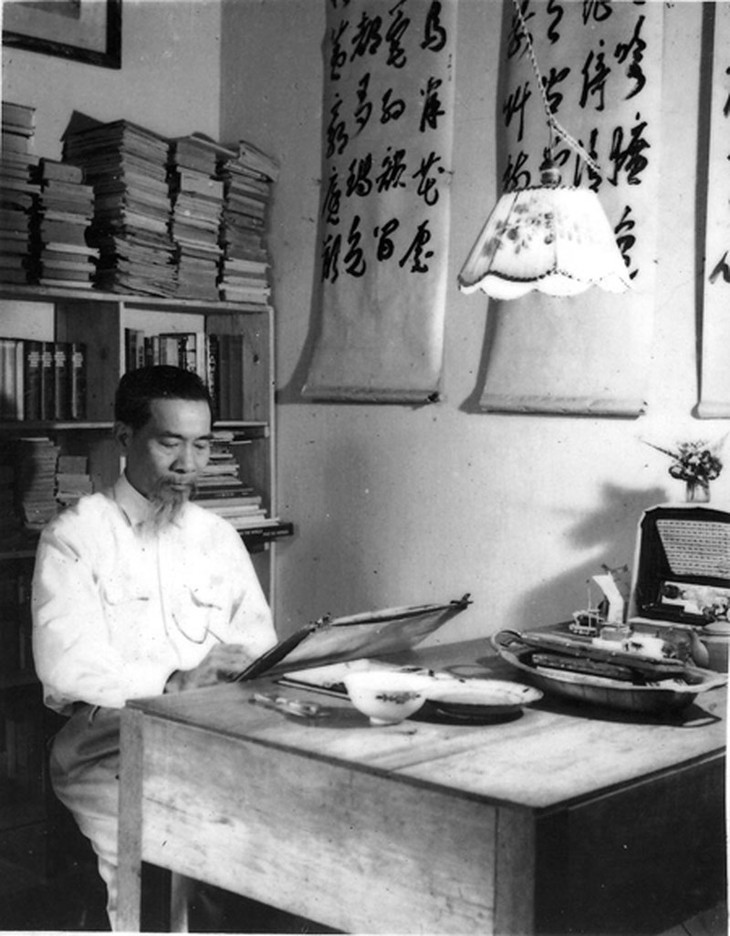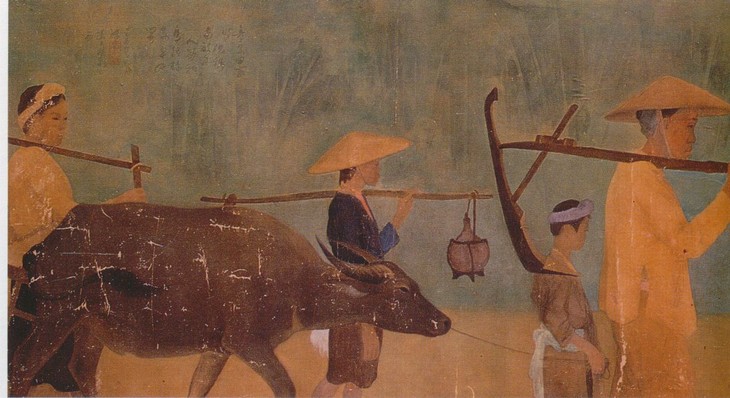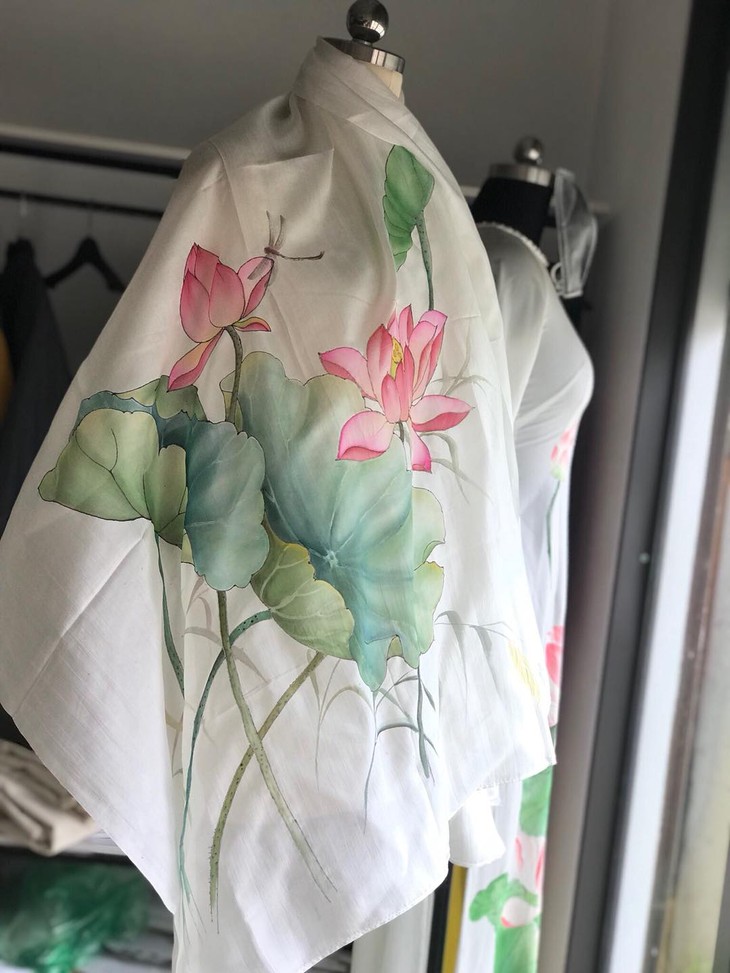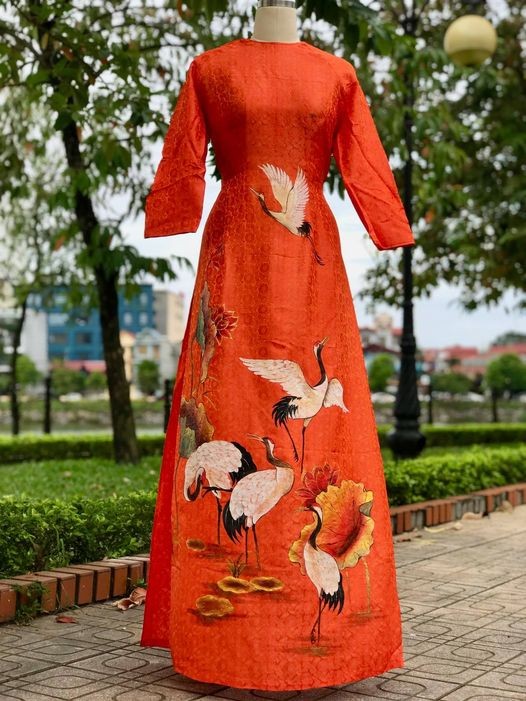Painting on silk appeared in Vietnam hundreds years ago and has played an important role in Vietnamese folk arts. After a long period of evolving techniques and styles, silk painting reached its peak during the 1930s, when artists from the Indochina Fine Arts College combined Western arts with Oriental aesthetics to create a new synthesis in silk painting. The pioneering artist at that time was Nguyen Phan Chanh, whose most famous silk paintings are “Rice washing”, “Count and capture”, “Fortune seeing”, and “Going to the field”.
Chanh focused on layout and details of body parts and postures learned from Western painters rather than the ancient Chinese silk painters, according to Quach Phuong Thao, a Vietnam Fine Arts University student majoring in pedagogy of fine arts, who often hosts workshops on silk painting.
 Nguyen Phan Chanh is the pioneering silk painter in Vietnam. (Photo: Flickr.com) Nguyen Phan Chanh is the pioneering silk painter in Vietnam. (Photo: Flickr.com) |
At this workshop, people are fun playing with colors. They apply one color on top of another, often using different shades of the same color from light to dark until they get the color they want. They have to wait for a layer to dry before applying the next layer, so they use a hair dryer to shorten the waiting time.
To fully capture the panting process on silk, let’s follow Thao. She asks participants to make their sketches as detailed as possible. The more detailed a sketch is, the easier it is to reproduce on the silk.
Thao explains, "It’s really hard for the painter to be as spontaneous when painting on silk as when painting with oil or lacquer. Thinking and painting at the same time is almost impossible, because as you paint, the color is absorbed quickly by the fabric, so you cannot correct it if it’s wrong. Silk panting is totally different from painting using acrylic, which allow the painter to layer over the wrong color.”
When you have a satisfactory sketch, the next step is placing the sketch on framed silk and tracing the picture with a pencil. Next, coloring. Amateur painters are advised to color the lines first to avoid washing the silk in case you paint the wrong color, which may wash away both the pencil lines and the other colors, said Thao. Once you’re done coloring on silk. You have two options to store your silk paintings.
“You can hang the framed silk paintings as décor items. If you want to remove the frame, use glue to stick a sheet of poonah paper on the painting and wait until it dries to harden it a little bit. Then you can roll it and store it in a cabinet or travel with it. Otherwise, the softness and silkiness make it hard for you to hang the painting without a frame,” Thao elaborated.
Among all the steps of painting on silk, Thao believes controlling colors is the most critical. You want the colors to spread on the fabric. Mixing too much color with too little water, or using colors alone without water are common mistakes that create harsh lines on your painting that cannot be removed. You cannot use a white color, either, because it will turn opaque. The beauty of a silk painting comes from a smooth blend of colors. There may be harsh lines, of course, but they are created intentionally by the painters.
 "Going to the field" is one of the most famous paintings by Nguyen Phan Chanh. (Photo: Pinterest) "Going to the field" is one of the most famous paintings by Nguyen Phan Chanh. (Photo: Pinterest) |
Thao’s workshop draws Vietnamese and foreign painters alike.
Nguyen Hai Linh, a painter and one of the participants at the workshop, said that coloring is the biggest challenge.
Linh said, "I used to pain oil on canvas. With silk painting, we use water color, which is very different from oil painting. The oil color is very thick when the water color is very thin and it uses a lot of water as well. So it means that I have to wait for the surface to dry so that I can paint little by little on top of it. Unlike oil painting that I can paint layers over layers simultaneously without waiting for it to dry. It’s quite different between those two."
She went on to say, "I didn’t wait for the surface to be dry enough. I painted another layer on top of the wet surface, which is not really good with water color or silk, so my solution is I put the water on top of the mistake and I wipe it off, kind of wash it, wash all the colors that I add, so I wait for it to be dry again and put another layer on top of the dry silk."
Being asked about whether her result comes exactly as what she planned to paint initially, Linh said, "I didn’t plan anything when I start with this workshop because this is the first time I try silk painting. I just want to try how it’s like. Maybe it’s gonna be another medium that I will try in the future. I think it’s really rice. It’s kind of relaxing."
Erica Del Vecchio, an Italian woman, shared her thoughts after completing a painting of a green plant in a pot, "Today was the first time I paint on silk. I have never done it before. Literally I think, I could go home, I mean I buy all the materials at home and do everything at home. Painting on silk wasn’t as difficult as I thought. The most difficult was working with water color paint because when you are just a little too much water or a little too much paint, you completely change your painting. I think I can do it better next time because, you know, practice makes perfect."
A major application of silk painting is in the fashion industry. I reached out to Tran Huong, the founder of Co Art, one of the few shops in Hanoi that have pioneered water color on silk. Co Art’s painters create “ao dai” (traditional long dresses), silk scarves, and silk ties. Painting creates unique effects that dying cannot achieve, says Huong.
Painting techniques vary depending on the sort of fabric used: pure silk, twist silk, tussore, satin silk, and brocade silk.
Huong elaborated, "Because the way they weave the silk is different, the way we paint on it is different, too. For instance, satin silk has more horizontal threads and the water color quickly spreads on satin silk horizontally, so we need to control the color in this direction either by the brush or by auxiliary substances. Twist silk has half its threads of silk and the colors spread more slowly than on pure silk, so we control it by brush only without using auxiliary substances. Tussore is rough, so we can use normal colors to paint on it."
 Silk scarf painted by Co Art (Photo: Co Art Facebook) Silk scarf painted by Co Art (Photo: Co Art Facebook) |
When it comes to the colors to pain on her fashion products, Huong continues, “There are three types of colors. Normal colors are similar to acrylic colors which cover the fabric surface. Normal colors are suitable for shirts or dresses or any thick, rough fabric. Water colors are absorbed into both sides of the fabric but need special processing to retain the color after washing. Water colors are used to paint on ‘ao dai’ without destroying the silkiness of the fabric. Marbling colors are used to create unique, eye-catching patterns like veinstones that are not possible in dyed fabric. Marbling colors requires exact mixing with auxiliary substances. A masterful painter can even use several kinds of colors on one product.”
Huong has a passion for traditional Vietnamese images: red leaves of Indian almond trees falling on ancient houses, multi-colored lotus flowers, and red dragon flies on the water. Huong believes silk is the best medium in which to use those images to tell the story of Vietnam. Her love for everything about this country is transferred to her products, so users will feel it while wearing them. Huong is over the moon when customers praise the soulful eyes of her figures. In her five years with Co Art, Huong has made countless paintings on silk but the one she made for a last-stage cancer patient is the one she remembers best.
“Her mother came to see me and ordered an “ao dai” with a big lotus under rays of sunshine painted on the front. I know what the image implied. As she didn’t have much time left, I put away all other pending orders and painted this ‘ao dai’ for her. An art work is always affected by the feelings of the artist. When I completed that ‘ao dai’, I felt how thin and fragile the lotus is, but how beautiful in sunshine. It touched my heart,” Huong recalled.
Huong said she loves her “silk” dream and the folks she has met along the way. Silk and colors help Huong and her customers feel each other and understand each other.
 An "ao dai" set painted by Co Art (Photo: Co Art Facebook) An "ao dai" set painted by Co Art (Photo: Co Art Facebook) |
Silk paintings have been promoted in several exhibitions inside and outside the country since 2006. These exhibitions show that the art of silk painting has been preserved and promoted as an important part of the Vietnamese arts scene.